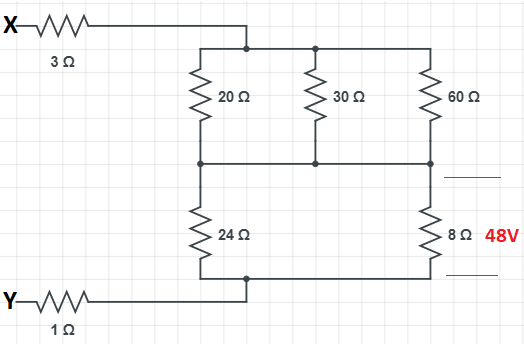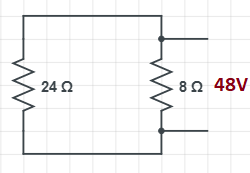Question
Question: The potential difference across \(8\Omega \) resistance is \(48V\) as shown in the figure. The value...
The potential difference across 8Ω resistance is 48V as shown in the figure. The value of potential difference across X and Y points will be

(A) 128V
(B) 160V
(C) 80V
(D) 62V
Solution
In the given circuit the resistors are connected in both parallel and series connection from the point X to the point Y. In this connection a particular parallel connection has a potential difference of 48V. We have to find the net potential difference across X and Y. Find the current through the circuit using the given potential difference across the parallel connection and also find the net resistance across X and Y. Now we have the net current and the net resistance across X and Y. Apply ohm’s law to find the net potential.
Complete step by step answer:
Given,
In the given circuit, the below mentioned resistors are connected in parallel

Here,
RP1=20Ω
RP2=30Ω
RP3=60Ω
The total resistance of the above circuit is Rp
The total resistance of the resistors connected parallel is given by
⇒RP1=R11+R21+R31
⇒RP1=201+301+601
⇒RP1=603+602+601
⇒RP1=606
⇒RP11=101
⇒RP1=10
In the given circuit, the below mentioned resistors are also connected in parallel.

Here,
RP1=24Ω
RP2=8Ω
⇒RP1=R11+R21
⇒RP1=241+81
⇒RP1=241+243
⇒RP1=244
⇒RP21=61
⇒RP2=6
And also,
Given that the potential difference across 8Ω is 48V
Since RP2=8Ω and RP1=24Ω are connected in parallel the potential difference 48V is applied to both the resistors, we found the net resistance of this resistor circuit
⇒RP2=6
Given, V=48V
According to ohm’s law we know that
⇒V=IR
⇒I=RV
Substitute the given values
⇒I=648
⇒I=8A
The current through the circuit is I=8A
And the circuit becomes

The resistors are in series connection
The total resistance of the resistors connected parallel is given by
⇒RS=R1+R2+R3+...+Rn
⇒RS=RS1+RP1+RP2+RS2
⇒RS=3+10+6+1
⇒RS=20
The total resistance across X and Y is RS=20
The current through the circuit is I=8A
The potential difference across X and Y is given by the ohm’s law
⇒V=IR
⇒V=8×20
⇒V=160V
Hence the correct answer is option (B), 160V.
Note: Ohm’s law states that at constant temperature the potential difference across the conductor is proportional to the steady current flowing through the conductor.
⇒V∝I
⇒V=IR
V is the potential difference
I is the current
R is the resistance
